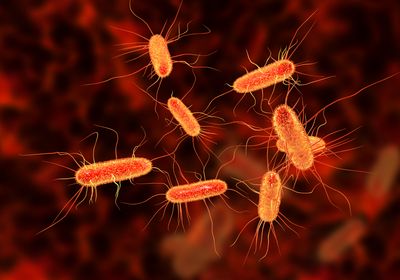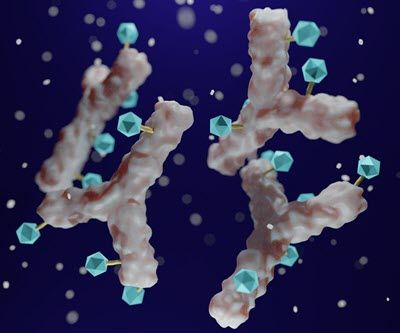ABOVE: © ISTOCK.COM, DR_MICROBE
Microorganisms are valuable manufacturing tools. Several biotechnology industries use Escherichia coli (E. coli) widely for production systems, so scientists have long played with the bacteria’s genome to make it more productive. However, the threat of infections from bacteriophages—viruses that infect bacteria—and the transfer of unwanted genetic material across organisms constitutes a heavy toll as it can halt production due to safety hazards and faulty products.
Because of this, researchers have spent years tinkering with E. coli in the hopes of making better, safer production tools and expanding the range of applications and the commercial potential of synthetic organisms. Now, in a study published in Nature on March 15, researchers from Harvard Medical School report a new E. coli strain that can resist viral infections but is unable to release its modified genes in the wild, reducing the risk of incorporating the modified genetic material into natural cells.
To create the new E. coli strain, dubbed Ec_Syn61?3-SL, the team started with the synthetic bacterium Syn61?3, generated by UK researchers in 2021, which has a reduced number of codons—the three-nucleotide sequences in DNA that correspond to a particular amino acid. Instead of the naturally occurring 64 sets, it only has 61, as three specific codons were excluded from its genome: two encoding for the amino acid serine and the other instructing protein assembly to stop. Furthermore, the UK team also removed from the bacterial genome the transfer RNA (tRNA) molecules that correspond to those codons. Since tRNAs are responsible for incorporating amino acids into a growing protein chain, bacteriophages that infected the reduced-codon bacteria would find its cellular machinery defective and unable to sustain viral replication, whereases the bacteria could still use the 61 codon sets to produce all the proteins it needed to live.
See “Streamlining the E. coli Genetic Code”
However, there is an incredible diversity of bacteriophages on Earth. “Bacterial viruses are everywhere, down the river here, on our shoes, in our garden,” Harvard University researcher Akos Nyerges, a coauthor of the new Nature paper, tells The Scientist. So Nyerges and colleagues at Harvard decided to test just how well the 2021 strain was able to fend off different types of viruses.
The team infected the Syn61?3 strain with viruses isolated from various environmental samples and found a group that could still infect it. When they characterized the successful virus’s genomic material, the team found that they all carried their own tRNA, allowing them to easily overcome the synthetic bacterium’s genetic limitation.
Because the original strain still had a degree of susceptibility to some bacteriophages, the researchers decided to work with the viral tRNAs to make the synthetic E. coli inaccessible to these bacteriophages too.
“We thought that if viruses are good at overcoming these barriers, we could exploit their strength to establish an artificial genetic code,” Nyerges says.
To make a new version of the E. coli strain that could resist even those successful bacteriophages, Nyerges and his team added to the bacteria’s genomic material trickster tRNAs: these were derived from the viruses’ own tRNAs, but were modified so that they would add leucine instead of serine when reading the viral genome. Both serine and leucine are found in nature but have very different compositions and properties. And that means that when these viruses infect the new Ec_Syn61?3-SL strain, the bacteria appear to provide the tRNAs they need but ultimately produce nonfunctional proteins. This approach created a unique genetic barrier between the synthetic bacteria and every bacteriophage. None of the viruses tested could overcome this molecular barrier and infect the engineered cells.
See “Best Bugs: How E. coli Evolves into a Stinkbug Symbiont”
However, a bacterium with no predator bacteriophages would have a major evolutionary advantage, so the researchers added built-in safety measures to keep it from flourishing in the environment in the event of a leak. The group inserted a codon for the unnatural amino acid biphenylalanine into the sequence of a bacterial protein essential for growth, making the new strain dependent on biphenylalanine. Consequently, synthetic E. coli growth is limited to environments where the unnatural amino acid is supplied to them, preventing the escape of synthetic genetic information into the wild, says Nyerges.
Though it’s impossible to rule out the existence of phage that can infect the synthetic bacterium somewhere in the Earth’s biome, “it’s doubtful that . . . viruses adapt to the synthetic genetic material,” says Nyerges.
“This paper added additional steps toward biocontainment, producing a more robust and self-contained system,” Rob Lavigne, a University of Leuven researcher who was not involved in the work, tells The Scientist. He adds that the techniques used to create the new E. coli could prove useful for other purposes as well, such as creating a fully synthetic genome for more complex organisms. In that regard, future research in bacterial biotechnology points towards generating strains with extra codons added in, giving scientists more opportunities to manipulate their biology. “This paper introduces a new concept that paves the way for future applications beyond E. coli. However, the concept will need further validations and tailored solutions,” says Lavigne.





